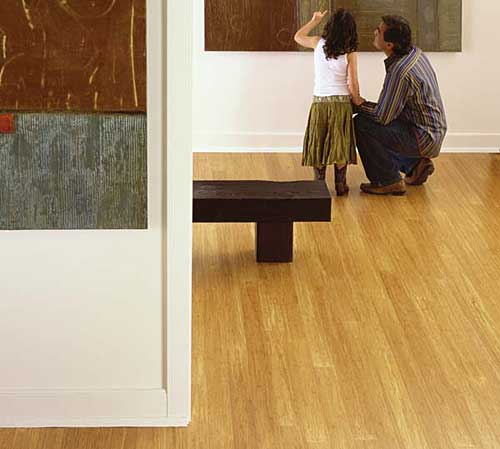Standing on Green Principles: Sustainable Flooring Choices and Life Cycle Assessment
Bio-based alternatives: For a long time, polyvinyl chloride-based tile, including vinyl composition tile, or VCT, has been widely used as a flooring finish product. Today, some companies involved in the manufacture of PVC tile are exploring alternatives. Vinyl tile and roll flooring have proven longevity and are manufactured efficiently. Generally a petroleum-based product, PVC should be reviewed in the extraction phase of the LCA like any other material-with attention to base materials, processing methods, transportation needs, energy requirements, and impact or disposal of process materials and by-products.
As a result, more than a decade ago, researchers involved with vinyl and VCT flooring production began researching, developing and producing alternatives for the constituent materials. As of the last few years, a number of PVC-free tile types have been introduced to the marketplace. The suppliers involved in these initiatives have been marketing what they callbio-based tilefor the commercial sector, aiming to assist projects looking for sustainable alternatives or for LEED ratings. According to one industry executive, bio-based tile products are designed to aggressively target LCA, and provide an attractive option for end-users and specifiers seeking higher LCA scores. The new bio-based products have been shown to be cost-effective and sustainable at a reasonable price point, although there is still rapid evolution of product formulations and choices of raw materials.
One benefit of the bio-based flooring products is that the raw materials can be locally harvested, and the tile formulations can include recycled content. Also, the bio-based components are derived largely from crops such as corn, which are not only locally available but also rapidly renewable. Various LCAs already score bio-based tile highly in the resource extraction stage, and there is still room to improve. Industry executives point out that new and improved processes and formulations will be introduced to the market in coming years from crop and plant sources other than corn.
ÂÂ
|
ÂÂ
|
ÂÂ
LCA STAGE TWO: MANUFACTURING
Manufacturing of finish products such as flooring is fraught with possible environmental peril, from the transportation of raw materials to the burning of fossil fuels and the introduction of additives in coatings, colors and sealants, to the management of waste and byproducts. Even if the project team chooses unfinished wood flooring, electing to sand and finish the floor once installed, the product was extracted, transported, cut and sized, with byproduct and waste created. Even a product so simply manufactured must be rigorously assessed at this stage in several ways.
Bamboo: Interestingly, an LCA of bamboo products, which also have the ability to mimic other wood types, will often reveal a surprisingly low amount of additives used, or of waste, associated with themanufacturing stage. Manufacturers like Teragren use bamboo shavings from the cutting process as fuel for boilers, and caramelized sugars from the burnt shavings color the bamboo culm as it is being heated and treated in a borate solution. Thus, properly treated bamboo can achieve an attractive color without chemical staining.
As mentioned, bamboo product is at its best and most durable when it ships directly from harvest to fabrication within two days, before mold and rot damage the bamboo culm. Being able to quickly transport the Moso to the factory means not only that borate solutions used will have the desired fungicidal, preservative effect, but also less energy needed for transportation-another "two-fer" of ecological benefit.










